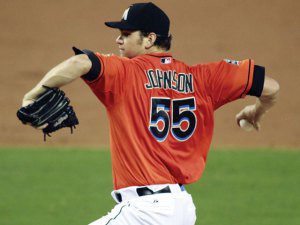
After coming to the Toronto Blue Jays in a blockbuster deal with the Miami Marlins, pitcher Josh Johnson got hit very hard in 2013.
Before a forearm strain ended his season, the right-hander posted a career-worst 6.20 ERA in 81.1 innings, the second-worst mark in the major leagues. Other than 15.2 innings in 2007, Josh Johnson had never posted an ERA above 3.81. Shortly before he was shut down, Johnson had a four-game stretch were he surrendered 31 hits and seven home runs in 16 innings, for a 14.06 ERA.
On October 1, Josh Johnson underwent elbow surgery to remove bone chips. The oft-injured hurler will be a free agent this offseason; is he worth taking a risk on after the ugly 2014?
First of all, he’s still Josh Johnson, a pitcher who has a lower career ERA and FIP than Justin Verlander. However, being Josh Johnson also frequently involves being injured, and he has averaged just 123 innings a year since becoming a starter in 2006.
Also, should potential suitors consider Johnson’s nightmare 2013 campaign an aberration, or a sign of declining skills?
Johnson’s peripheral stats do not indicate that his skills are in decline. While his 4.62 FIP was a career worst, his 3.58 xFIP was almost exactly his career average, and actually lower than the 3.73 he possessed in 2013, when he managed a 3.40 ERA.
His strikeout rate of 21.6 percent and his walk rate of 7.8 percent were very much in line with his career numbers. His groundball rate was slightly lower than average, but nothing out of the ordinary. Huge outliers were a strand rate more than 10 points below his average, a BABIP of .356, compared to a .298 mark entering 2013 and a HR/FB ratio of 18.5 percent, compared to a 7.2 percent mark before 2013. Rogers Centre is much more home run-friendly than Marlins Park, but that only explains a small part of the difference.
Ok, the peripherals don’t indicate a decline; has Johnson’s stuff or his command gotten worse? A look into the Pitch f/x data from BrooksBaseball should help answer this question.
Josh Johnson’s fastball doesn’t average 95 mph like it did in 2009-10 when he was one of the best 10 pitchers in MLB, but at 93, it still possesses good velocity, and it didn’t show a decline from 2012. Similarly, his whiff rate was the second best of his career, behind only his 2010 season.
While he dialed back his fastball usage in 2012 to compensate for a dip in velocity, Johnson’s fastball usage jumped back up in 2013. As you can guess, batters were all over that pitch. However, the whiff rate on his fastball was better than his career average. Josh Johnson continued the trend of moving away from the changeup, but that pitch has never been particularly effective for him, and he has never thrown it on more than 10.5 percent of his pitches.
The data does show that Johnson’s four-seam fastball has gradually flattened out, and it doesn’t have the elite “rise” it did back in 2009-10. It was significantly flatter in 2013, which may explain some of the jump in HR/FB ratio. The sinking fastball had more run than sink, and it produced fewer groundballs. He would be well-served to utilize his offspeed pitches more frequently.
His curveball and slider induced whiffs at a higher rate than his career average. The curveball, which Josh Johnson added to his repertoire in 2011, produced all-around solid results. In addition to a 19.0 percent whiff rate, hitters managed just a .238 batting average when they made contact, with only two extra-base hits.
Unlike the curveball, the slider was hit hard when batters did make contact. It had significantly less vertical and horizontal movement than in previous years. Perhaps this is an explanation for the vastly increased line drive rate, but this is a sample of 320 sliders thrown and 35 balls in play, so don’t jump to conclusions too quickly.
A look at Josh Johnson’s zone profile shows fewer pitches in the middle of the zone, but also fewer pitches in the zone in general, a trend that has continued for three years now. This could be a product of pitching in pain, or it could indicate that Johnson has less confidence in his stuff. It could also indicate declining command, but Johnson’s first pitch strike percentage was higher in 2013 than his career average, and his overall percentage of strikes was unchanged from the previous two years.
In sum, Johnson doesn’t have the elite stuff that he was working with in 2009-10. However, his results this year appear to be more of an aberration than a drastic decline in skills.
I am more inclined to believe in the still-solid strikeout and walk rates Johnson managed in 2013, than the atrocious BABIP and HR/FB rates, especially when the sample size is 250 balls in play and 80 fly balls. He’s probably not an ace anymore, but he could provide #2 or #3 value.
Johnson still throws hard, and he can still miss bats. As always, he is an injury risk. However, he has the same career FIP- as Zack Greinke, who signed a six-year deal for $147 million last winter. And Johnson is a year younger than Greinke. Depending on how the market takes into account his 2013 season, he could be a real bargain for a savvy team. Look at what ace turned cast-off turned ace Francisco Liriano has done for the Pittsburgh Pirates this year.
